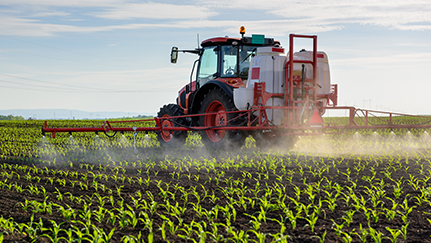Pesticides such as herbicides, fungicides and insecticides are often used to protect yields, livestock and stored feedstuffs. Used improperly, they create health, safety and liability hazards for anyone handling or applying them. Raising agricultural pesticide safety awareness was the inspiration for February’s National Pesticide Safety Education Month when the Cooperative Extension Service and Center for Integrated Pest Management established it in 2018.
Nationwide knows the importance of safety for everyone working around pesticides. Safe, responsible mixing and application minimizes the risks of pesticide exposure or misapplication—whether you’re a custom applicator or farmer managing your own pesticide applications.
“Misapplications are a common cause of pesticide-related losses we see on farms around the country,” said Jason Berkland, an agronomist and senior associate vice president, Nationwide Agribusiness. “National Pesticide Safety Education Month is a good reminder to make sure you have the correct PPE and are practicing safe application techniques.”
Avoid these common application errors
- Adding the wrong chemical. Confirm you’re using the right product. Always ensure you’re mixing the right products and following all label instructions. Double-check label directions before you begin handling a pesticide.
- Tank contamination. Clean all tanks, lines and mixing vats thoroughly. Failing to do so can lead to contamination of pesticides, which could result in crop damage or illegal residues. Always rinse all mixing and spraying equipment between sprays.
- Pesticide drift. Pay close attention to environmental conditions before, during and after application. Wind speed and direction, humidity and daytime temperatures all influence the off-target movement potential of the application.
- Non-uniform application. Calibrate all equipment for the specific pesticide you’re applying. This helps maximize its longevity and minimizes misapplication issues like spray drift.
Protect yourself with the right PPE
As with any chemical you handle, it’s crucial to take proper precautions to safeguard yourself and others around you. Pesticides require appropriate personal protective equipment (PPE) to be worn whenever you open, mix, apply or dispose of pesticide containers.
“Determining the right PPE is the first step in making sure you’re minimizing work-related accidents and injuries,” said Berkland. “Following label instructions helps you know what PPE you should be wearing based on the pesticide you're handling in your ag operation.”
Some common PPE for handling pesticides include:
- Skin protection. Wear long-sleeve shirts, long pants, shoes with socks, and chemical-resistant gloves to shield your skin from direct exposure to pesticides.
- Respiratory protection. Use appropriate respirators to prevent inhalation of harmful fumes.
- Eye protection. Safeguard your eyes by wearing protective eyewear or goggles.
Risk management services and solutions
Nationwide offers consultative risk management services, training and various online resources to help you safeguard your operation from pesticide risks. Related articles include:
Find more tools and resources on MyNSightOnline.com. Nationwide customers have exclusive access to agronomy templates, training videos and safety programs to help enhance their operations and reduce risks on their farms or agribusinesses.
